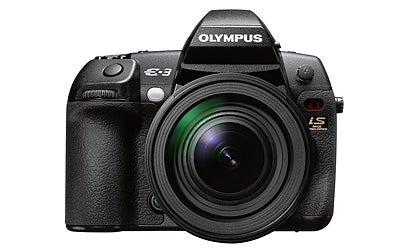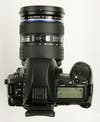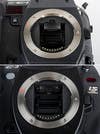Hands On: Olympus E-3 Digital SLR
Olympus reaches for pros with a rugged body, swiveling LCD, and some autofocus magic.

We may earn revenue from the products available on this page and participate in affiliate programs. Learn more ›
If the Olympus E-1, the company’s first high-end DSLR, never caught on among pros, you can blame its painfully slow, insensitive autofocus system. But one look at the new Olympus E-3 ($1,700, estimated street, body only) was enough to convince us that, this time around, Olympus has come up with not just a much better AF system, but a much better camera all around.
Our impression comes from using a preproduction, fully operational camera that wasn’t ready for testing in the Pop Photo Lab.
We expect it to do at least as well on the image quality front as the company’s consumer-level Evolt E-510, since the E-3 packs a similar 10.1MP Live MOS sensor (manufactured by Panasonic). Because of its smaller size and 4:3 aspect ratio, the E-3 will also have a 2X 35mm lens factor. While 10.1MP isn’t on the bleeding edge of resolution in this price category, the E-3’s advanced image processing may suppress noise even further than the E-510 at ISOs up to ISO 3200.
The E-3 feels rock-solid, well balanced and easy to hold. The body, comprising a three-piece, molded, magnesium-alloy shell and impressive gasketing and weathersealing, alone puts it in pro territory.
Olympus improved the pentaprism viewfinder — larger, with better eye relief and none of the E-1 ‘s tunnel-vision effect. The company claims the viewfinder offers nearly 100 percent accuracy and 1.15X magnification.
Another noticeable improvement: Unlike its predecessor, the E-3 has both a pop-up flash and wireless flash control for three flash groups (with four channels each).
Kudos to the 2.5-inch LCD monitor, which can be swung to the side and turned up and down (for overhead or waist-level shooting), as well as turned inward for protection.
Most other new DSLRs in the E-3’s price range sport larger LCDs, and the 3-inchers on the Nikon D300 and Sony Alpha 700 have nearly twice the resolution of the E-3’s 77,000 pixels (230,000 dots). But the E-3’s LCD is bright and provides sufficient detail to navigate menus or inspect images.
As with the Evolt E-510, the monitor can show the calming effects of the built-in, sensor-based stabilization system when live preview mode is turned on. It can also display camera exposure settings before shooting, simulate over- and underexposure settings, and zoom in up to 10X on any part of the image for manual-focus assist.
The autofocus system is highly sensitive and significantly faster, with selectable 11 AF zones. Olympus says that the AF’s unique design uses a layered, slightly offset, CMOS sensor array to improve accuracy and low-light sensitivity. As a result, all 11 AF zones should be active cross-sensor types with any aperture lens. This may be the best AF system we’ve ever seen on an Olympus DSLR.
Olympus also claims it has increased the E-3’s burst speed and capacity to 5 frames per second, up to the card’s capacity for finest-quality JPEGs or 17 RAW images — still a little slower than the Canon EOS 40D or Nikon D300.
In all, the E-3 looks like the DSLR that Olympus promised to deliver to pros and advanced shooters.
| Product Type | Product type | Single-lens reflex Live View digital camera with interchangeable lens system |
| Memory | CompactFlash Type I/II, Microdrive, xD-Picture Card (Dual-Slot) | |
| Sensor size | 0.68 in (17.3 mm) (H) x 0.51 in (13.0 mm) (V) | |
| Lens mount | Four Thirds Mount | |
| Effective Pixels number | Effective Pixels number | 10.1 million pixels |
| Image Pickup Unit | Product type | Live MOS Sensor |
| Total no. of pixels | Approx. 11.8 million pixels | |
| Aspect ratio | 1.33 (4:3) | |
| Filter array | Primary color filter (RGB) | |
| LPF | Fixed type | |
| IR cut filter | Hybrid type | |
| Dust reduction | Supersonic Wave Filter (dust reduction system for image sensor) | |
| Recording | Recording format | DCF, DPOF compatible/Exif, PRINT Image Matching III |
| File format | RAW (12-bit), JPEG, RAW+JPEG | |
| Recording image size | [RAW] 3648 x 2736 pixels | |
| [JPEG] 3648 x 2736 pixels – 640 x 480 pixels | ||
| File size | RAW: 3648 x 2736 compressed Approx. 11MB | |
| Large: 3648 x 2736 Super fine (1/2.7 compressed) Approx. 6.8MB | ||
| 3648 x 2736 Fine (1/4 compressed) Approx. 4.7MB | ||
| Viewfinder | Product type | Eye-level single-lens reflex viewfinder |
| Field of view | Approx. 100% | |
| Viewfinder magnification | Approx. 1.15x (−1m-1, 50mm lens, infinity) | |
| Eye point | Approx. 20 mm (-1m-1) | |
| Diopter adjustment range | -3.0 – +1m-1 | |
| Focusing screen | Changeable at a service center (Neo Lumi-Micro Mat screen supplied, possible to change to gird mat type) | |
| Eyepiece shutter | Built-in type | |
| Eye cup | Interchangeable type EP-5/6/7, EP-7 is supplied (Magnifier Eyecup ME-1 is available) | |
| Depth of Field Preview (optical view finder & Live View) | Yes, by preview button | |
| Live preview | Available to set to Fn button | |
| View finder information | Aperture value, Shutter speed, Record mode, AF confirmation mark, Flash, WB, AE lock, Number of storable still images, Exposure compensation value, Metering mode, Battery warning, Exposure mode, AF frame (super impose), IS, Bracket, ISO value | |
| Live View | Live View | Live MOS Sensor for still picture shooting is used, 100% field of view, |
| Exposure adjustment pre-view, White balance adjustment pre-view, Gradation auto pre-view | ||
| Grid line displayable, 5x/7x/10x magnification possible, MF/S-AF, | ||
| AF frame display, AF point display, Shooting information, Histogram | ||
| AF | Phase-difference detection system with mirror down. | |
| Image stabilizer | System | Built in (Imager shift image stabilizer) |
| Mode | 2 modes (2 dimensional activation, 1 dimensional activation) | |
| Effective compensation range | Approx. 5 EV steps (in maximum effect) | |
| Monitor | Product type | HyperCrystal LCD (semi-transmissive TFT color LCD) |
| Size | 2.5 inches | |
| Total no. of pixels | Approx. 230,000 pixels | |
| Playback field of view | 100% | |
| Brightness control | Auto/Manual 15 levels | |
| Focusing | AF system | TTL phase-difference detection system |
| Focus mode | Single AF (S-AF) / Continuous AF (C-AF) / Manual Focus (MF) / | |
| S-AF + MF / C-AF + MF | ||
| Focusing point | 11-cross points multiple AF | |
| Focusing point selection | Single point, Group area, All points are selectable. | |
| AF luminance range | EV -2 to 19 (at 20℃, ISO 100) | |
| AF illuminator | Built-in flash (external flash available) | |
| AF lock | Locked at first position of Shutter button in Single AF mode / AEL button (customizable) | |
| Focus tracking | Interlocked with Continuous AF mode | |
| Focus aid | Available | |
| Exposure Control | Metering system | TTL open-aperture metering system |
| (1) Digital ESP metering (49-points multi pattern metering) (2) Centre weighted average metering | ||
| (3) Spot metering (approx. 2% for the viewfinder screen. Highlight / shadow bases are available) | ||
| Metering range | EV 1 – 20 (Digital ESP metering, Center weighted average metering, Spot metering) | |
| (At normal temperature, 50mm f2, ISO 100) | ||
| Exposure mode | (1) P: Program AE (Program shift can be performed) (2) A: Aperture priority AE | |
| (3) S: Shutter priority AE (4) M: Manual | ||
| Underwater program AE | Available to set to Fn button | |
| ISO sensitivity | AUTO (ISO 100 – 3200) / Manual (ISO 100 – 3200), 1/3 or 1 EV steps | |
| Exposure compensation | ±5 EV in 1/3, 1/2, 1 EV steps selectable | |
| AE lock | AEL button (customizable) | |
| Exposure bracketing | 3 or 5 frames in 0.3, 0.7, 1EV steps selectable | |
| ISO bracketing | 3 frames in 0.3, 0.7, 1EV steps selectable | |
| White Balance | Auto WB system | Hybrid detection system with Live MOS sensor and dedicated external sensor. |
| Preset white balance | 7 settings (3000K – 7500K) Lamp (3000K), Fluorescent 1 (4000K), Fluorescent 2 (4500K), Fluorescent 3 (6600K), Daylight (5300K), Flash (5500K), Cloudy (6000K), Shade (7500K) | |
| White balance compensation | ±7 steps in each R-B/G-M axis (in Auto WB / Preset WB mode / One touch WB) | |
| Custom white balance | 1 setting can be registered at Kelvin temperature (2000K – 14000K) | |
| One-touch white balance | 4 custom settings can be registered | |
| White balance bracketing | 3 frames in 2, 4, 6 steps selectable in each R-G/G-M axis. | |
| Color Mode | Color matrix | sRGB, Adobe RGB |
| Picture Mode | Mode | Vivid, Natural, Portrait, Muted, Monotone, Custom (default setting: Natural) |
| In custom mode, basic 5 modes and adjustment is available. | ||
| Adjustment parameter | Contrast, Sharpness and Saturation level available in 5 steps for Vivid, Natural, Portrait and Muted | |
| Contrast and Sharpness level available in 5 steps for Monotone. | ||
| In custom mode, gradation level available in 4 steps. | ||
| Filter effect | Yellow, Orange, Red or Green filter available for Monotone | |
| Picture tone | Sepia, Blue, Purple or Green tone available for Monotone | |
| Gradation | 4 levels (Auto, High key, Normal, Low key) | |
| Shutter | Product type | Computerized focal-plane shutter |
| Shutter speed | P(Ps), S, A, M mode: 60 – 1/8000 sec. | |
| Bulb: up to 30 minutes. (selectable longest time in the menu. Default: 8 min.) | ||
| 1/3, 1/2, or 1EV steps selectable. | ||
| Self-timer | Operation time: 12 sec., 2 sec. (cancel available) | |
| Remote cable release | Available (with optional RM-CB1 Remote cable.) | |
| Optical remote control | Operation time: 2 sec., 0 sec., bulb control available (with optional RM-1 remote control) | |
| Anti shock mode | Available (1 to 30 sec selectable) | |
| Drive | Drive mode | Single-frame shooting, Sequential shooting H, Sequential shooting L, Self-timer, Remote control |
| Sequential shooting speed | Approx. 5 frames/sec. in sequential shooting H, 1 to 4 fps selectable in sequential shooting L. | |
| Max. recordable pictures | RAW mode: Max. 16 frames. | |
| JPEG mode: Depends on compression ratio and no. of pixels (Large normal mode: up to card capacity with SanDisk Extreme III) | ||
| Integrated Flash | Built-in flash | Retractable flash, GN=13 (ISO 100.m) |
| Compatible external flash | FL-50R, FL-36R, FL-50, FL-36, FL-20, STF-22, SR-11 | |
| Flash control mode | TTL Auto (TTL pre-flash mode), Auto, Manual | |
| Flash mode | Auto, Red-eye reduction, Red-eye reduction slow sync., Slow sync at 1st curtain, Slow sync at 2nd curtain, Fill-in, Manual (1/4, 1/16, 1/64), Off. | |
| Synchronization speed | 1/250 sec. or less, Super FP up to 1/8000 sec. | |
| Flash intensity control | Up to ±3 EV in 1/3 EV steps | |
| Flash bracketing | 3 frames in 0.3, 0.7, 1 EV steps selectable. | |
| Wireless flash control | Compatible external flash | FL-50R, FL-36R |
| Control method | Triggered and controlled by built-in flash light | |
| Flash control mode | TTL Auto (TTL pre-flash mode), Auto, Manual, FP TTL Auto, FP Manual. | |
| Number of channel | 4 channels | |
| Group setting | 3 groups | |
| Control panel | Information | WB setting, WB compensation notification, B/W mode notification, Record mode, Exposure mode, ISO sensitivity |
| BKT notification, Flash mode, Drive mode, Recordable still image number, Storable number of images, | ||
| Exposure compensation value, Metering mode, Activated AF points, Focusing mode. | ||
| Back light timer | 8 sec. | |
| Super control panel | Information (shooting) | Exposure mode, Shutter speed, Aperture value, Exposure compensation value bar, Exposure compensation value |
| Flash compensation value bar, Flash compensation value, ALE notification, Flash compensation notification | ||
| NR notification, BKT notification, AF illuminator deactivated notification, Color space, Flash mode | ||
| ISO sensitivity, Drive mode, WB setting, WB compensation value, Picture mode, Metering mode, Focusing mode | ||
| File name, Image parameter, Gradation, Date, Storable number of images, Record mode, Battery warning. | ||
| Information | Exposure mode, Shutter speed, Aperture value, Exposure compensation value bar, Exposure compensation value | |
| (wireless flash commander) | Flash compensation value bar, Flash compensation value, ALE notification, Flash compensation notification | |
| NR notification, BKT notification, AF illuminator deactivated notification, Color space | ||
| Wireless channel setting, Built-in flash intensity, Group setting | ||
| Playback | Playback mode | Single-frame, Index (4/9/16/25 frames), Calendar, Close-up ( 2 – 14X), |
| Slideshow, Picture rotation (auto mode available), Light box | ||
| Information display | Histogram (independent luminance / RGB available), | |
| Highlight / Shadow point warning, AF frame, Shooting information | ||
| Menu | Languages | Japan: Japanese, English US: English, French, Spanish, Portuguese Europe: English, French, German, Spanish, Italian, Russian, Czech, Dutch, Danish, Polish Others: English, Simplified Chinese, Traditional Chinese, Korean Additional one language is possible to download. |
| Reset & custom setting | Custom reset | 2 setting recordable |
| My mode | 2 setting recordable | |
| Image Editing | Erasing function | Single frame, All frames, Selected frames |
| Protect function | Single frame, Selected frames, Release protect (Single/All selected) | |
| Copy between media | Single frame, All frames, Selected frames | |
| RAW picture editing | RAW development | |
| JPEG editing | Resize (producing another file), Gradation auto | |
| Print function | Print reservation (DPOF), Direct print (PictBridge compatible) | |
| Input/Output | PC interface | USB 2.0 High Speed for storage and camera control (MTP mode is available) |
| Video connector | Video out (Video: NTSC/PAL selectable) | |
| Flash attachment | Hot shoe | |
| DC-in | Yes (AC-1 compatible) | |
| Sync. Cord Socket | For Attaching External Strobe Cord. | |
| Power Requirements | Battery | BLM-1 Li-ion battery (included) |
| CR123 x 3 with LBH-1 | ||
| Sleep mode | Available (1, 3, 5, 10 min., off selectable) | |
| No. of recordable pictures | Approx. 610 shots (optical viewfinder) | |
| (with 50% flash light) | (with BLM-1 under CIPA testing standard) | |
| Power battery holder | HLD-4 compatible | |
| Dimensions/Weight | Dimensions | 5.6 in. (W) x 4.58 in. (H) x 2.9 in. (D) /142.5mm (W) x 116.5mm (H) x 74.5mm (D) (excluding protrusions) |
| Weight | 1.79lbs (28.2 oz.) / 810 g (body only) | |
| Operating Environment | Temperature | 32 F – 104 F / 0 – 40℃ (operation) -4 F – 140 F / -20 – 60℃ (storage) |
| Humidity | 30 – 90% (operation) / 10 – 90% (storage) | |
| Splash proof | Yes | |
| Box contents | E-3 body, Li-ion battery BLM-1, Li-ion battery charger BCM-2, USB cable, Video cable, Shoulder strap, OLYMPUS Master CD-ROM, Instruction manual, Warranty card. |

These-sketches-show-the-design-evolution-of-the-Ol

The-Olympus-E-3-has-a-swiveling-LCD-a-rarity-in

The-E-3-can-shoot-at-up-to-five-frames-a-second-a

Olympus-claims-exceptionally-fast-Autofocus-speeds

This-chart-shows-the-frequency-of-location-of-prim

Detail-of-the-dual-layer-houndstooth-pattern-11-p

Detail-of-the-E-3-s-AF-sensor-assembly-and-optical

The-left-diagram-shows-the-Viewfinder-view-while

Schematic-of-the-dual-layer-design-of-the-AF-senso

The-Olympus-E-3-has-a-maximum-shutter-speed-of-1-8

Olympus-claims-minimal-lag-time-and-virtually-no-s

The-Olympus-E-3-uses-dedicated-engines-for-Image-S

The-E-3-s-dual-card-slots-will-hold-a-CF-and-xD-ty

Detail-of-the-internal-location-of-the-Image-Stabi

Detail-of-the-sensor-assembly

Exploded-cross-section-of-the-floating-sensor-asse

Schematic-of-microlenses-on-the-10MP-sensor-showin

X-ray-view-of-the-viewfinder

Detail-of-the-viewfinder-display-and-functions

X-ray-view-of-the-magnesium-construction

More-x-ray-views-of-the-E-3

Obverse-and-reverse-view-of-the-magnesium-chassis

X-ray-view-of-the-weathersealing-in-the-Olympus-E

Details-of-the-SSW-integrated-sensor-cleaning-mech

Olympus-E-3-Pro-Caliber-The-new-Olympus-E-3-is-a

Olympus-E-3

Olympus-E-3

Olympus-E-3

Olympus-E-3

Olympus-E-3

Olympus-E-3

Olympus-E-3

Olympus-E-3

Olympus-E-1-and-E-3-right

Olympus-E-1-and-E-3-right

Olympus-E-1-and-E-3-right

Olympus-E-1-and-E-3-right

Olympus-E-1-and-E-3-right

Olympus-E-1-and-E-3-right

Olympus-E-1-and-E-3-right

Olympus-E-1-and-E-3-right

Olympus-E-1-and-E-3-right

Olympus-E-1-and-E-3-bottom